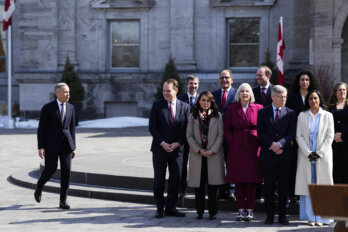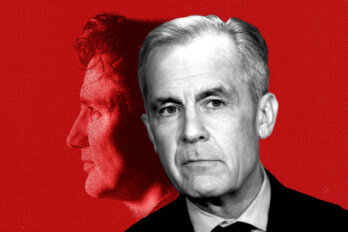Listen to an audio version of this story
For more audio from The Walrus, subscribe to AMI-audio podcasts on iTunes.
When eight cruise missiles struck the International Peacekeeping and Security Center, outside of Lviv, Ukraine, on March 13, they left parts of the complex destroyed. Launched from Russian aircraft, the attack reportedly killed thirty-five people and injured another 134. Around three weeks earlier, Russian ground troops, helicopters, and tanks had crossed the border and invaded Ukraine. Amid the barrage of violence, the strike on the IPSC compound stood out. The military facility is less than twenty-five kilometres from the border with Poland, and any attack on Poland, a NATO member, would trigger a response by NATO countries against Russia. The attack resonated with one Canadian soldier watching the news from more than 6,000 kilometres away. “That’s where I lived for seven months,” Nathan, a combat arms officer, says. “You kind of bombed my home.”
Nathan was one of hundreds of soldiers from Canada, the US, and the UK who, beginning in 2015, had lived at the IPSC while deployed on bilateral training missions to Ukraine. (Nathan requested the use of a pseudonym due to security concerns.) Operation Unifier, the Canadian mission, had a clear goal: to train Ukraine’s military and security forces, in part to align their methods and structures with NATO standards. In 2014, Russian forces invaded and annexed Crimea, a peninsula in Ukraine’s south. Ukraine had also become embattled in its eastern provinces against Russian-backed separatists. Canadian soldiers worked with more than 30,000 Ukrainian counterparts, at a cost to the federal government—in addition to other forms of development and humanitarian aid—of $890 million. After seven years, the training mission was abruptly suspended in mid-February, as Russian troops mustered along Ukrainian borders. Amid escalating tensions, Canada pulled its forces from the country.
In the first month of what Russian president Vladimir Putin called a “special military operation,” more than 2 million refugees fled Ukraine to neighbouring countries, cities were shelled, thousands of Ukrainian and Russian soldiers were killed, and countless civilians were caught in between or targeted. Russian attacks focused predominantly on the country’s eastern and southern regions. The intention of Russia’s March 13 strike on the IPSC, in Ukraine’s west, was clear, Nathan says. “It was a message to NATO.” Operation Unifier, among other countries’ training operations, had been intended to bolster Ukraine’s resilience against Russian aggression, but the reform of its military came to be seen by many as a step toward NATO membership.
Fearing that active military support against Russia would spark a third world war, NATO countries were left with two options for opposing this most recent invasion: supplying Ukrainian forces with arms and equipment or imposing unprecedented economic sanctions on Russia. As the invasion intensified and doubts grew about whether NATO’s actions would be enough, those who took part in Operation Unifier—back home in Canada or at new posts in Poland—were left wondering what legacy they had left on the ground.
Deployed to Ukraine a few years into Operation Unifier, Nathan says that he and some of his fellow Canadians walked in with a certain level of arrogance. They assumed that the underfunded Ukrainian army wouldn’t know what it was doing. He recalls beginning with a lesson on operating a practice firing range, but Nathan says it didn’t take long to understand that, for the most part, the Ukrainians weren’t keen to be taught rudimentary skills; they wanted lessons that applied to the war they were already years into fighting. “We kind of realized that, writ large, the Ukrainian army doesn’t need to learn those things,” Nathan says. “They’re an old army. They’ve got experience in multiple wars. A lot of the soldiers we were training there were at war in 2014, 2015, 2016.”
The focus shifted to practical application, troubleshooting the issues the Ukrainians were having on their deployments. Nathan recalls one Ukrainian soldier asking him what to do if his armoured vehicle ran out of fuel while in the field. “We wouldn’t allow that to happen,” Nathan told him matter-of-factly. “They still worked with the old Soviet mentality from the sixties and seventies of how they manage their logistics,” Nathan says. “It was a lot of supply dumps”—a method where soldiers on the front lines retrace their advances, sometimes a great distance, to refuel and restock rather than employing dedicated logistics groups with specialized vehicles to bring food, equipment, and people to the front. To what extent these logistics lessons are now being implemented is yet unclear, but Ukrainians have proven that they understand the weaknesses of the supply-dump method by attacking and exploiting these vulnerabilities in the Russian supply chains that still mirror the old Soviet style.
The unofficial role of Unifier was to help the Ukrainian army move on from an inflexible Soviet legacy. The country’s rigid, top-down military command structure, another artifact of Soviet military doctrine, in which every order comes from high up and lower commanders aren’t emboldened with on-the-ground decision-making power, also needed to be reworked. The reform and training undoubtedly helped spark hope for a better future—one that Ukrainians could choose for themselves. But the presence of NATO soldiers teaching Western military doctrine led many to believe it wasn’t just about training a more effective army but was instead a prerequisite for something bigger.
Throughout Operation Unifier, there was an issue of expectations. “When we talked about conventional war,” Nathan says, “we always used if. So, ‘if you get attacked.’ And they would always say, ‘No, it’s when.’ . . . Now, today, they’re obviously vindicated for saying when.” Nathan made friends among his Ukrainian counterparts, but “there was no way we could stay there,” he says. “It was NATO’s standing orders that, in case of conflict, [we would leave]. The Ukrainians knew this. We had to leave. It wasn’t a question of, ‘Good luck.’ It was more like, ‘We can’t stay here because you’re not a NATO country.’”
According to Nathan, some Ukrainian trainees still held out hope that shedding the Soviet mindset that permeated their military was a means to an end, that a transformation was required if the country were ever going to fulfill its ultimate goal of launching a bid to join NATO. In 2017, Canadian lieutenant-colonel Mark Lubiniecki told local media, “The Ukrainian Armed Forces are well on their way to NATO compatibility, in part because of the hard work of our Canadian Armed Forces members here in Ukraine, and this is an outstanding legacy to be a part of.” Member countries made no official promise, but their continued presence in the country made Ukraine’s former president, Petro Poroshenko, optimistic that this was a path to membership.
Stéfanie von Hlatky, Canada Research Chair on gender, security, and the armed forces, doesn’t believe the mission was ever intended to be a path to NATO membership. “The capacity building and training efforts that Canada has provided in Ukraine are only one piece of that puzzle,” she says. “Bringing the country up to NATO’s standards involves, certainly, defence-sector reform and military capacity building, but there’s also a political question and a question of the civilian institutions in the country. So it’s a lot more comprehensive than what Canada’s Operation Unifier was providing.”
The monumental task of reforming and growing a military that was described by one analyst as “decrepit” in 2014 and by Ukraine’s then chief of the general staff Viktor Muzhenko as “an army literally in ruins” has largely been a success story, borne out in a test no one would have wished on the people of Ukraine. Western military experts have hypothesized that Ukraine’s expansion of its military capabilities since 2014 has kept its government from quickly falling, something some believe was a surprise to Putin. Ukrainian soldiers have taken full advantage of newly delivered tools, including anti-tank weapons, as well as their new skills. They have held control of the capital, and NATO estimates that, in the first month of fighting, between 7,000 and 15,000 Russian soldiers were killed.
“Let’s say Ukraine manages to remain a sovereign country,” Von Hlatky says. “Then there’s another phase of rebuilding. And that’s where having that bilateral relationship at the political level is very important. But the military-to-military ties that were created before the war can also be somewhat reactivated after the war.” One part of Canada’s military legacy in Ukraine has become clear: the fact that the country has been able to resist for so long is a testament to the training it received.
Two days after the Russian strike on the IPSC, on March 15, Ukrainian president Volodymyr Zelenskyy addressed the Canadian House of Commons, thanking members of Parliament for their support in sanctioning Russia and for providing military aid, including weapons, to his country. Zelenskyy also extended the request that’s become a mantra for many in the Ukrainian Canadian community: close the skies by implementing a no-fly zone over Ukraine.
Applause thundered through the chamber as Zelenskyy finished his address. The moment underscored the complicated legacy of Canada’s military role in Ukraine since 2015. Support from NATO has been invaluable, but further involvement is ultimately unavailable. Elizabeth May, the former leader of the Green Party, addressed this tension: “A no-fly zone will risk a wider war and even a nuclear war. We know these reasons are solid, even though they ring hollow. But we must use every tool, and I fear that the tools we have in front of us are inadequate to the task. President Zelenskyy, we do not want to let you down. We fear that we may inevitably let you down, but we will find every tool we can find, and where there aren’t adequate tools, by God, let’s invent them.” While Canada has helped implement economic sanctions against Russia and has now committed to sending rocket launchers, body armour, and rations as part of $25 million in military aid to Ukraine, it seems to have been insufficient to stop the bleeding.
Ukrainian soldiers have fought over the past seven years to rid themselves of the Soviet-era structures and constraints their military was born into. Now, they must train every person who volunteers or is conscripted to take up arms in the hope that the country’s Soviet past is not also its future. The legacy of Canada’s military involvement in Ukraine speaks to the limitations of NATO as a whole: countries that fall outside the bloc, no matter the bilateral relationships that might exist, and seemingly no matter the human cost, can be attacked, and Canada and its NATO allies will be forced to take limited actions while watching from afar.
“There are people out there now who are alive because of the Canadian training, because of the British training, because of the American training—no question,” says British military consultant Glen Grant, who worked in Ukraine during Operation Unifier. He remains critical, however, that more wasn’t done. He thinks NATO countries’ wariness of upsetting Russia in the past decade meant a failure to protect Ukraine in terms of providing both military equipment and combat-focused training before it was urgent. “The initial [training] focus was all medical. It was defensive stuff. Canada didn’t want to be seen to be helping anybody to kill anybody,” Grant says. “It’s nice helping them after they’re shot. But it would have been a lot better if we were helping them before they’re shot, so they don’t get shot.”



